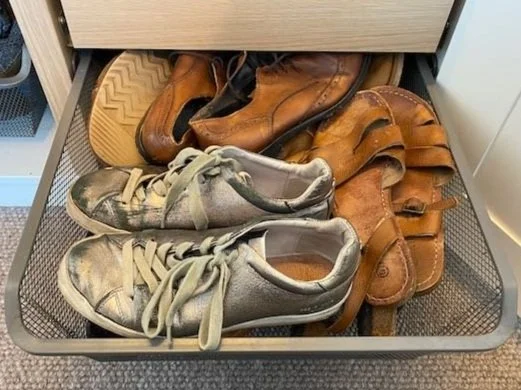Dormant Shoes: Why do we keep shoes we no longer wear?
This question is part of a larger research study into ‘dormant things’ which considers why we keep things we no longer use. Perhaps more importantly, what do the things we no longer use tell us about people’s lives, memories and relationships?
The dormant things project considers a wide range of objects from old electrical cables, keys, and free plastic toys, amongst innumerable other things. One such object is shoes. Here, I will take some examples of ‘dormant shoes’ from my fieldwork to think about why people keep them and what they tell us about people’s lives.
Dormant shoes are often kept in boxes in an attic, or garage, away from everyday sight and usage. Although shoe racks in a hall would seem like a place for ‘active’ shoes – those selected on a daily basis – for many people these shoes are a combination of those worn every day, occasional shoes, and those that are never touched. This mirrors my earlier research into women’s wardrobes which included a whole spectrum of clothing – including items that are never worn.
For one of my participants, her shoe rack in the hall is stuffed full of shoes – often several pairs for every space in the rack to keep them off the floor. Around half of these are used, and the others include pairs she ‘might’ wear one day. Some dormant things, then, are kept out for imagined or projected future use. For this participant, her eldest daughter now has the same shoe size and she wonders whether she might wear them, as she has done with a pair of old Converse trainers that have now been given a “new lease of life”.
On the rack are two pairs of Doc Martin boots (‘DMs’) that she had twenty years ago at university. Her sister hand-painted and decorated one pair so she “can't get rid of them”, and the other pair was gifted by a friend. She cannot get rid of these as she has had them for a long time, and they have clear personal and relational meanings. Moreover, the pair her sister decorated mark them out as hers, as unique. When she does get them out to wear, she laughingly questions “should I still be wearing the DMs I wore when I was twenty?!?” The boots sit on the rack as if they could be worn again, but they are not. She is more ambiguous over whether her daughter would wear these shoes but knows that this would, in her words, give them ‘life’ again. The DM boots here carry a reminder of her student days and her sister. This example is one of many where people kept shoes that remind them of a time in their life or of other people.
One of the most common types of shoes for people to keep is a child’s first pair. These were more often than not kept in a memory box together with other objects from babyhood and early childhood. By being kept in the box, the shoes become special, and their size becomes a material reminder of how small a child once was. Many shoes kept, however, were not kept because they were special or even beautiful but instead because of their perceived usefulness. One participant keeps a pair of shoes in the bottom of her wardrobe that by her admission she hates, saying: “Every time I put these on I hate them because they’re ugly”. They are however sensible walking-style shoes so are kept for their practicality, even though they are never worn. They could be worn but as they are too ugly she always takes them off.
These shoes are interesting; keeping shoes for ‘potential’ use is quite common, even if that potential is never realised. One participant keeps a shelf of high-heeled shoes at the top of her wardrobe that she knows she will “probably never ever wear”. She can’t get rid of them just in case she needs a pair of shoes for a wedding or other occasion. She wears flat shoes on an everyday basis which she now also does for special occasions, therefore, the shelf of shoes is rarely touched. Another participant has a shelf of high-heeled shoes that she knows she will never wear because, due to her arthritis, she has had to buy “fancy flat shoes” for weddings. She keeps the high-heeled shoes as if getting rid of them would be explicitly acknowledging she will never wear heels again. In her case, the keeping is more complex than just potential use.
Taken together, these examples of dormant shoes show the range of meanings they have and thus reasons for keeping them: some are replete with meanings of other people and of former times in a life, others are kept due to a sense of potential use, even if they get no use. Shoes are of the body and as such remind us of the bodies that wore them (such as tiny toddler feet) – even when our bodies are no longer able to wear them (being out of practice or having arthritis). Shoes are also small enough for people to keep without feeling the need to get rid of them. Even the ugly shoes, or those kept for practical reasons, dormant shoes matter, they are evocative of other people, and times, even as a more mundane reminder of practicality and use.

